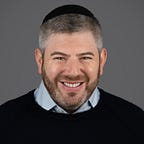Footprints
What’s in a name?
Shakespeare once famously wrote, “That which we call a rose by any other name would smell as sweet.” The Bard was correct: a rose could just as easily have been named anything else. But it would still be the same flower. And since a rose is called a rose, doesn’t it deserve to be called by its name?
Which begs the question: don’t we all?
Imagine a world in which none of us has a name of our own. How would we identify ourselves and one another? Perhaps we’d be reduced to our features — that tall man with the bushy beard or the blond woman with the glasses.
Maybe we’d be identified by our personality traits and accomplishments. The outgoing little girl with the best grades in the class or the brilliant doctor who performed a perfect surgery.
But those would be the exceptions.
In other words, it would never work. Because our names are critical to our very selves — not just for the sake of introductions and discussions but also for the ability to be and to be seen by others as unique individuals.
Simply stated, our names are the basis of our identities.
We just started reading the Book of Exodus, known in Hebrew as Sefer Shemot, which translates to “names.” This title draws attention and significance to the role which names play in the unfolding saga of Jewish slavery, redemption and revelation.
The first parshah, the eponymously named Parshah Shemot, begins, “And these are the names of the children of Israel who came into Egypt…” (Exodus 1:1–2). It goes on to list all the names of the tribes of Israel as they come down from Egypt, counting not just each family but each person within each family. The counting of each name highlights the importance of every individual in the Jewish story.
But it’s not just Sefer Shemot that has driven me to think about the importance of individual names and the role they play in our identities.
Consider the life of Adolfo Kaminsky, a French Jew whose unique skillset and dedication to humanity helped to save thousands of Jews during the Holocaust. His obituary in the New York Times begins:
Adolfo Kaminsky’s talent was as banal as could be: He knew how to remove supposedly indelible blue ink from paper. But it was a skill that helped save the lives of thousands of Jews in France during World War II.
Kaminsky was just a teenager when he joined the resistance and began using his talent to remove typically Jewish-sounding names from French ID cards, replacing them with names that would not attract Nazi attention.
Asked to forge birth certificates, baptismal certificates and food ration cards for Jewish children, he worked for two days straight, telling himself, “In one hour I can make 30 blank documents. If I sleep for an hour 30 people will die.”
Kaminsky’s expertly forged documents allowed countless Jews to evade capture and flee to safety in other countries. His story dovetails with the beginning Sefer Shemot.
We live our lives moving forward. When we do look back, it’s typically with reminiscence, regret or remembrance. Rarely do we live our lives in reverse. Rarely do we consider our legacy until the end of our existence looms nearer.
Sometimes, we aren’t granted the old age or good health to do so at all.
If we pay close enough attention, though, there are triggers — like Kaminsky’s story was for me — that compel us to reflect upon the impact of our actions and to ask ourselves: What can I do to help shape the world that I leave behind when I die?
Surely, a 17-year-old Adolofo Kaminsky, who worked for a dry cleaner, never dreamed that his talent for stain removal would save countless lives. Yet there are Jewish families around the world today who surely owe their very existence to him. Not just because of his unique skill but because he was so steadfastly dedicated to using that skill for good.
Surely, we all have something to contribute — a passion, a talent, a hobby which we can harness and direct for the greater good. In doing so, we take control of our legacy and do our part to leave the world a better place for generations to come.
What will your legacy be?
